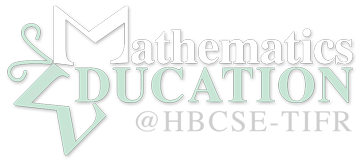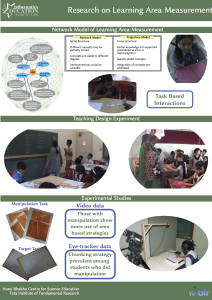Approach to teaching beginning algebra
Much prior research on algebra learning has focused on developing aspects of algebraic thinking such as generalisation and understanding variation and functions. Research on how students meaningfully absorb the syntax and structure of symbolic expressions has been limited. We developed a visually-guided, structural approach that identifies the additive components of a symbolic expression (called “terms”), and develops a meaningful understanding of the relation between the value of an expression and its “terms”.
Key publications
Banerjee, R., & Subramaniam, K. (2015). Emerging ideas of generalization, proof and proving among grade 6 students. In Proceedings of epiSTEME-6: International conference to review research on Science, TEchnology and Mathematics Education, Mumbai, India: Cinnamonteal publishing.
Banerjee, R., & Subramaniam, K. (2012). Evolution of a teaching approach for beginning algebra. Educational Studies in Mathematics, 80 (3):351–367.
Subramaniam, K., & Banerjee, R. (2011). The arithmetic-algebra connection: A historical-pedagogical perspective. In Cai, J. & Knuth, E. (Eds.), Early Algebraization: A Global Dialogue from Multiple Perspectives, 87-107: Springer.
Banerjee, R., Subramaniam, K., & Naik, S. (2008). Briding Arithmetic and Algebra: Evolution of a Teaching Sequence. In O. Figueras et al. (Eds.), Proceedings of the Joint Meeting of International group of the psychology of mathematics education- 32 and PME-NA XXX (PME29), Vol 2, 121-128, Morelia, Mexico: PME.
Fractions and multiplicative reasoning
This research aims to develop a teaching approach that explicitly integrates different interpretations of fractions (part-whole, ratio, quotient, measure, operator), anchoring these in contexts of equal sharing. It also seeks to link fraction understanding with the larger domain of multiplicative reasoning.
Key publications
Subramaniam, K. (2013). Research on the learning of fractions and multiplicative reasoning: A review. In Chunawala, S. (Ed.), The epiSTEME Reviews: Research Trends in Science, Technology and Mathematics Education, (Vol. 4). New Delhi, India: Macmillan.
Subramaniam, K. & Naik, S. (2010). Attending to Language, Culture and Children’s thinking as They Learn Fractions. In Pinto M. M. F. & Kawasaki T.F (Eds.), Proceedings of the 34th International Conference for Psychology in Mathematics Education. Belo Horizonte, Brazil: PME.
Naik, S. and Subramaniam, K. (2008). Integrating the measure and quotient interpretation of fractions. In O. Figueras et al. (Eds.), Proceedings of the Joint Meeting of International group of the psychology of mathematics education- 32 and PME-NA XXX (PME29), (Vol. 4, pp. 17-24), Morelia, Mexico: PME.
Measurement of area
Area measurement connects and enriches the two critical domains of geometry and number. However, building the conceptual connection between these two domains is full of challenges. Area can be seen as an important entry point to the deep connection between various numeric and geometric structures. Therefore, we are trying to reformulate the area concept as a network requiring an integration of various other spatial and numerical concepts. Using this theoretical model, we are trying to develop a spiral of tasks which can address different aspects of the area concept. And then trying out these tasks with students to explore whether and how they can connect these different individual concepts in the network.
Key publications
Rehman, J., & Subramaniam, K. (2016). Constructing the concept of area measurement in a classroom. In Proceedings of the 13th International Congress on Mathematical Education, Hamburg, Germany: ICME.
Rahaman, J., Subramaniam, K. & Chandrasekharan, S. (2013). A network model of the mathematical concept of area. In G. Nagarjuna, A. Jamakhandi, & E. M. Sam (Eds.), Proceedings of epiSTEME-5: International conference to review research on Science, TEchnology and Mathematics Education, (pp. 300-306), Margao, India: Cinnamonteal Publishing.
Subramaniam, K. & Bose, A. (2012). Measurement units and modes: The Indian context. In Proceedings of the 12th International Congress on Mathematical Education- 12, (pp. 1974-1983). Seoul, South Korea: ICME.
Rahaman, J., Subramaniam, K., & Chandrasekharan, S. (2012). Exploring the connection between multiplicative thinking and the measurement of area. In Proceedings of the 12th International Congress on Mathematical Education- 12, (pp. 1964-1973). Seoul, South Korea: ICME.
Research Poster on Measurement of Area
Full list of Publications on learning strands
Banerjee, R., & Subramaniam, K. (2015). Emerging ideas of generalization, proof and proving among grade 6 students. In Proceedings of epiSTEME-6: International conference to review research on Science, TEchnology and Mathematics Education, Mumbai, India: Cinnamonteal publishing.
Rehman, J., & Subramaniam, K. (2016). Constructing the concept of area measurement in a classroom. In Proceedings of the 13th International Congress on Mathematical Education, Hamburg, Germany: ICME.
Takker, S., Kanhere, A., Naik, S., & Subramaniam, K. (2013). From relational reasoning to generalization through number sentence tasks. In G. Nagarjuna, A. Jamakhandi, & E. Sam. (Eds.), Proceedings of epiSTEME-5: International conference to review research on Science, TEchnology and Mathematics Education, (pp. 336- 342). Homi Bhabha Centre for Science Education, Mumbai, India: Cinnamonteal Publishing.
Subramaniam, K. (2013). Research on the learning of fractions and multiplicative reasoning: A review. In Chunawala, S. (Ed.), The epiSTEME Reviews: Research Trends in Science, Technology and Mathematics Education, (Vol. 4). New Delhi, India: Macmillan.
Banerjee, R., & Subramaniam, K. (2012). Evolution of a teaching approach for beginning algebra. Educational Studies in Mathematics, 80 (3):351–367.
Kumar, R. S., & Subramaniam, K. (2012). One teachers struggle to teach equivalent fractions with meaning making. In Proceedings of the 36th conference of the International group for the Psychology of Mathematics Education, (Vol. 4, pp. 290). Taipei, Taiwan: PME.
Takker, S., & Subramaniam, K. (2012). Towards Conceptualizing a Teaching Sequence to Promote Early-Algebraic Thinking. In Proceedings of The National Meet on Celebration of National Year of Mathematics, Department of Education in Science and Mathematics, New Delhi: NCERT.
Subramaniam, K., & Banerjee, R. (2011). The arithmetic-algebra connection: A historical-pedagogical perspective. In Cai, J. & Knuth, E. (Eds.), Early Algebraization: A Global Dialogue from Multiple Perspectives, 87-107: Springer.
Banerjee, R., Subramaniam, K., & Naik, S. (2008). Briding Arithmetic and Algebra: Evolution of a Teaching Sequence. In O. Figueras et al. (Eds.), Proceedings of the Joint Meeting of International group of the psychology of mathematics education- 32 and PME-NA XXX (PME29), Vol 2, 121-128, Morelia, Mexico: PME.
Naik, S. and Subramaniam, K. (2008). Integrating the measure and quotient interpretation of fractions. In O. Figueras et al. (Eds.), Proceedings of the Joint Meeting of International group of the psychology of mathematics education- 32 and PME-NA XXX (PME29), (Vol. 4, pp. 17 – 24), Morelia, Mexico: PME.
Subramanian, J., Subramaniam, K., Naik, S., & Verma, B. (2008). Combining Share and Measure Meaning of Fractions to Facilitate Students’ Reasoning. In Proceedings of the International Conference of Mathematics Education- 11, Monterrey, Mexico: ICME Available online at http://tsg.icme11.org/document/get/823
Banerjee, R., & Subramaniam, K. (2007). Exploring student’s reasoning with algebraic expressions. In Proceedings of the 30th International Conference for Psychology of Mathematics Education. Seoul, South Korea: PME. (poster)
Subramaniam, K., & Naik, S. (2007). Extending the Meaning of the Fraction Notation: A Teaching Experiments. In Proceedings of Episteme-2: International conference to review research in Science, TEchnology and Mathematics Education, (pp. 223 – 227). New Delhi, India: Macmillan.
Banerjee, R., & Subramaniam, K. (2005). Developing Procedure and Structure Sense Of Arithmetic Expressions. In H. L. Chick and J. L. Vincent (Eds.), Proceedings of the 29th Conference of the International Group for the Psychology of Mathematics Education (PME29), Melbourne, Australia: PME.
Banerjee, R., Subramaniam, K., & Naik, S. (2005). Designing an Instructional Sequence for Transiting from Arithmetic to Algebra in the Middle School. In Proceedings of Episteme-2: International conference to review research on Science, TEchnology and Mathematics Education, (pp. 218 – 222). New Delhi, India: Macmillan.
Naik, S. S., Banerjee, R., & Subramaniam. K. (2005). Understanding Student’s Reasoning While Comparing Expressions. In P. Clarkson et al. (Eds.), Proceedings of the annual conference of the mathematics education research group of Australasia Inc. Melbourne, Australia: MERGA.
Banerjee, R., & Subramaniam, K. (2004). ‘Term’ as a bridge concept between arithmetic and algebra. In Proceedings of Episteme-1: International conference to review research on Science, TEchnology and Mathematics Education, (pp. 76 – 77). Mumbai, India:Homi Bhabha Centre for Science Education. Presentation
Naik, S., Banerjee, R., & Subramaniam, K. (2004). Students’ use of language and symbols in reasoning about arithmetic expression. In Proceedings of Episteme-1: International conference to review research on Science, TEchnology and Mathematics Education, (pp. 92 – 94). Mumbai, India:Homi Bhabha Centre for Science Education.
Subramaniam, K., & Banerjee, R. (2004). Teaching arithmetic and algebraic expressions. In M. J. Hoines & A. B. Fuglestad (Eds.), Proceedings of the 28th conference of Psychology of Mathematics Education, (Vol. 3, pp. 121-128), Bergen, Norway: PME
Subramaniam, K. (2004). Naming Practices that Support Reasoning about and with Expressions. In Proceedings of the International Congress on Mathematics Education-10, Denmark: ICME.

